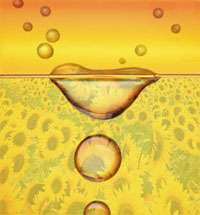How is biodiesel manufactured?
The manufacture of biodiesel is a deceptively simple process, so much so that it may be done on a small scale in a home laboratory. Operations may be scaled up to large-volume operations using the same basic process. However, for biodiesel to be marketed commercially as fuel, it must meet the ASTM Standard Specification for Biodiesel Fuel (B100) Blend Stock for Distillate Fuels (D6751-02).
Here's how biodiesel is produced from vegetable oils in a non-technical nutshell: Vegetable oils are primarily triglycerides, containing 7-13% glycerin. The biodiesel process turns the oils into esters (i.e., the combustible biodiesel), and separates the esters from the glycerin. The denser glycerin sinks to the bottom and the biodiesel floats on top, facilitating separation.
The biodiesel process is called transesterification. Chemically, what happens is that alcohol (typically methanol because of low-cost simplicity of the chemical process) is used to react with the vegetable oil in the presence of a caustic catalyst (typically caustic soda -- NaOH or sodium hydroxide or lye). The caustic catalyst causes the methanol to react with the oil forming glycerin and crude biodiesel. Approximately 90% of the input oil is converted into combustible biodiesel fuel. The products are then processed further ("chemically washed") to remove excess methanol and unreacted catalyst, which may be reused. The main byproduct/co-product of the process is glycerin, which is used extensively in the cosmetic industry and for other chemical processes.
As stated in the first paragraph of this page, for biodiesel to be marketed commercially as fuel, it must meet the ASTM Standard Specification for Biodiesel Fuel (B100) Blend Stock for Distillate Fuels (D6751-02). The ASTM standard includes requirements to meet specifications for flash point (min. 130 deg/C), water and sediment (<0.05 vol %), kinematic viscosity at 40 deg/C (1.9-6.0 mm2/sec), sulfated ash (<0.02 wt %), sulfur (<0.05 wt %), copper strip corrosion (#3 max.), Cetane (47 min.), cloud point, carbon residue (0.05 wt %), acid number (<0.80 mg KOH/gm), free glycerin (<0.02 wt %), total glycerin (<0.24 wt %), phosphorous content (<0.001 wt %), and distillation temperature (< 360 deg/C).
While, small-scale biodiesel operations can produce biodiesel that will perform in diesel engines, these kinds of operations are unlikely to consistently produce ASTM-certifiable biodiesel. Using non-ASTM certified fuel in an engine increases the potential risk of plugging fuel injectors, resulting in costly repairs.


0 Comments:
Post a Comment
<< Home